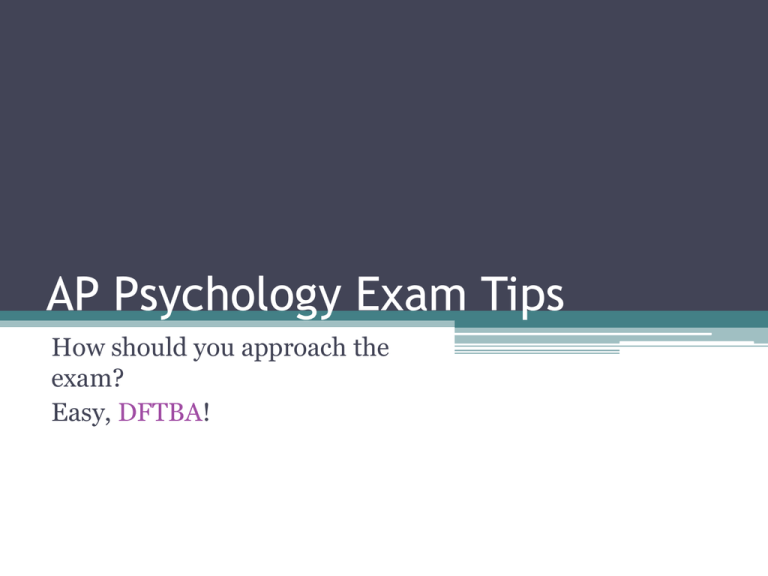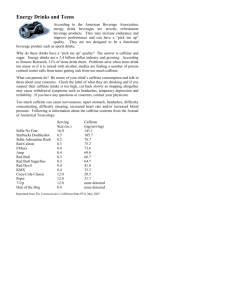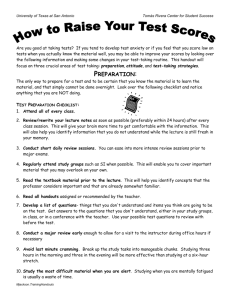AP Psychology Exam Tips
advertisement

AP Psychology Exam Tips How should you approach the exam? Easy, DFTBA! Exam Score Distribution The process of grade setting takes place immediately after the Reading (where FRQs are scored). Composite scores are translated into AP grades by setting boundaries for 2014 each grade based on a statistical technique called equating. This is so performance 5s 4s 3s 2s 1s from year to year can be compared—looking at common questions on both exams. 18.5 27.1 19.9 13.6 20.9 Don’t fret! The point totals vary from year to year. Here’s some advice based on year’s past… 5 students earned every point possible (150/150). Students performed very well on social psychology questions. Score of 3: generally earn a composite of at least 85 Score of 4: generally earn a composite of at least 95 2013 Score of 5: generally earn a composite of at least 110 5s 4s 3s 2s 1s I cannot guarantee scores 21.2 26.7these scores, 19.6because REMEMBER 13.0 19.5 vary from year to year. Your BEST BET, therefore, is to simply answer all the questions correctly. So, DFTBA 2 students earned every point possible (150/150). Students performed very well on the abnormal psychology questions. In case you want to see the calculation process… • Also, you are no longer penalized for guessing/wrong answers! (If you read differently, the exam was changed in 2011.) ▫ ANSWER ALL MC ?s Multiple Choice Section • Read the question carefully. • Try to answer the question yourself before reading the answer choices. • Guess. Try to eliminate answer choices. • Drawing a picture may help you. • Don’t spend too much time on any one question. Multiple Choice Section • Every multiple choice question has three important parts ▫ Stem ▫ Correct answer ▫ Distractor options Heuristics “rules of thumb” • Carefully read the question. Look for key words—not just vocabulary. • Words like “never” and “always” are called absolute qualifiers. It’s rare that these are the answer choice. • Before looking at the answer choices, try to visualize the correct answer. See if you can find one that is similar. • Write in your booklet. Jot down quick notes & underline key words. Heuristics “rule of thumb” • Mark any question you skip in your booklet. You have about 45 seconds for each question. DO NOT spend too much time on one question. • DO NOT OVERTHINK! • Guessing becomes a better gamble if you can eliminate some choices. GUESSING does NOT count against you. • Change an answer ONLY if you have good reason to. [retrieval cue] Heuristics “rule of thumb” • Time flies…when you are having fun ▫ Get a grand-paw watch. ▫ Set it to 12 (both hands at the #12) ▫ You have 70 minutes total. MC: Stand Alone Questions • Majority of ?s are stand alone • Words in the stem provide you the info you need to answer the question • Covers a distinct topic • Easy, medium, and hard (no order) • Example 1. A graphical representation of correlational data is called a a. Bell curve b. Chi square c. Scatterplot d. Bimodal distribution e. Skewed distribution MC: Grouped Questions • Given a stimulus (sentences or graph) that help you answer a set of questions • Make sure you understand the stem and then attack the easy questions first • Example stem ▫ A researcher is interested in determining if the amount of caffeine students consume influences the number of hours they study. To do this, he varies the amount of caffeine among three groups of students: group 1 drinks 0 servings of caffeine a day; group 2 drinks 3 servings; group 3 drinks 8 servings. Students keep a log tracking how long they study each dy. After the study is over, the researcher collects the logs and obtains an average number of hours studied per group. MC: Grouped Questions 1. In this experiment, ____ is the independent variable. a. b. c. d. e. Group 1 Group 3 Number of hours studied Amount of caffeine consumed Number of students per group MC: Grouped Questions 1. In this experiment, ____ is the dependent variable. a. b. c. d. e. Group 1 Group 3 Number of hours studied Amount of caffeine consumed Number of students per group General Strategies • • • • Pace yourself. Use the process of elimination. Be aware of patterns and trends. Have the right approach. Where to go… • www.jjanneckchs.weebly.com ▫ AP Exam Resources Practice exams…get familiar with the format. ▫ ALL Unit Notes • Crash Course Psychology on YouTube https://www.youtube.com/playlist?list=PL8dPuuaLjXtOPRKzVLY0jJY-uHOH9KVU6







